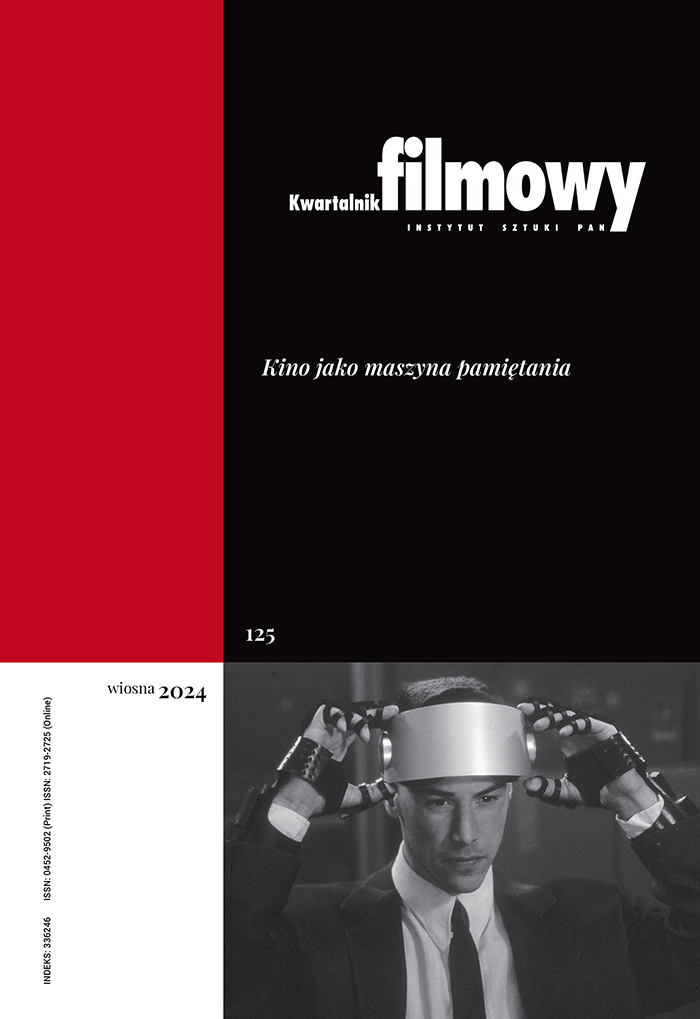The Dark Side of Poland? Neo-Noir and Police Cinema in the Work of Patryk Vega
Abstract
The transcultural aspect is an important feature of the new cinema noir (neo-noir). In contemporary pop culture neo-noir has become one of the dominant trends, easily adapting to the local conditions of national cinematography. The article is devoted to one of the Polish films that fall into this category. Films and TV series by Patryk Vega refer to neo-noir and the convention of American police films. Genologic considerations aside, the author looks at the nature of the connections between Polish neo-noir and American film. Is police film of the neo-noir variety merely an inspiration for Vega, or does it undergo reinterpretation and an attempt at adaptation of Hollywood conventions? Or perhaps we should look at the work of the director as a selected works by Vega, including those made for the cinema (Pitbull, Special Forces) and those made for television (among others: Instinct, Dark Side of the City).
Keywords:
Patryk Vega, neo-noir, noir, police cinemaReferences
Durys E.: Amerykańskie popularne kino policyjne w latach 1970-2000. Łódź 2013.
DOI: https://doi.org/10.18778/7525-861-5
Google Scholar
Haltof M.: „Amerykańskie kino polskie”: „Psy”, pozytywna wtórność i polityczny przekaz. W: Polskie kino popularne. Red. P. Zwierzchowski, D. Mazur, Bydgoszcz 2011.
Google Scholar
Kempna-Pieniążek M.: Neo-noir. Ciemnie zwierciadło czasów kryzysu. Katowice 2015.
Google Scholar
Kempna-Pieniążek M.: Polskie adaptacje estetyki noir i neo-noir – rekonesans historyczny. „Biblioteka Postscriptum Polonistycznego” 2015, nr 5: Adaptacje II: Transfery kulturowe.
Google Scholar
Lee H.: The Shadow of Outlaws in Asian Noir: Hiroshima, Hong Kong and Seoul. W: Neo-noir. Red. M. Bould, K. Glitre, G. Tuck. New York 2010.
DOI: https://doi.org/10.7312/boul6018-011
Google Scholar
Lipińska U.: Szczegóły tworzą realizm. „Magazyn Filmowy SFP” 2014, nr 38.
Google Scholar
Melosik Z.: Kryzys męskości w kulturze współczesnej. Kraków 2006.
Google Scholar
Nieracka A.: Wokół kategorii filmowego remake’u. „Kwartalnik Filmowy” 2014, nr 85.
Google Scholar
Nurczyńska-Fidelska E.: „Czarny realizm”. O stylu i jego funkcji w filmach nurtu współczesnego. W: „Szkoła polska” – powroty. Red. E. Nurczyńska-Fidelska, B. Stolarska. Łódź 1998.
Google Scholar
Pietrasik Z.: Broń się. Najbardziej lubimy oglądać amerykańskie filmy polskie. „Polityka” 1997, nr 15.
Google Scholar
Przylipiak M., Szyłak J.: Kino najnowsze. Gdańsk 1999.
Google Scholar
Sikora K.: Patryk Vega nakręcił dwugodzinny spot wyborczy PiS-u, http://natemat.pl/116193,patryk-vega-nakrecil-dwugodzinny-spot-wyborczy-pis-u-sluzby-specjalne-to-zbior-wszystkich-teorii-spiskowych-prawicy.
Google Scholar
Skwara A.: Film Stars Do Not Shine in the Sky Over Poland: The Absence of Popular Cinema in Poland. W: Popular European Cinema. Red. R. Dyer, G. Vincendeau. London 1992.
Google Scholar
Wager J.B.: Neo-noir/Retro-noir. The Encyclopedia. Eds. A. Silver, E. Ward, J. Ursini, R. Porfirio, New York–London 2010.
Google Scholar
Zając K.: Ideologia i ikonografia w filmach retro-noir, „Studia Filmoznawcze” 2010, nr 31: Film noir.
Google Scholar
Authors
Magdalena Kempna-Pieniążekkwartalnik.filmowy@ispan.pl
University of Silesia Poland
Adiunkt w Zakładzie Filmoznawstwa i Wiedzy o Mediach Uniwersytetu Śląskiego w Katowicach, redaktor naczelna internetowego dwutygodnika kulturalnego „artPAPIER”. Autorka monografii: Dziw niejsze niż fikcja. Rola wyobraźni w filmach Marca Forstera (2012), Formuły duchowości w kinie najnowszym (2013), Marzyciele i wędrowcy. Romantyczna topografia twórczości Wernera Herzoga i Wima Wendersa (2013) oraz Neo-noir. Ciemne zwierciadło czasów kryzysu (2015). Prowadzi badania dotyczące estetyki noir i neo-noir, problemów duchowości i religijności w kinie oraz współczesnych wariantów autorstwa filmowego.
Statistics
Abstract views: 342PDF downloads: 127
License
Copyright (c) 2016 Magdalena Kempna-Pieniążek

This work is licensed under a Creative Commons Attribution 4.0 International License.
The author grants the publisher a royalty-free non-exclusive licence (CC BY 4.0) to use the article in Kwartalnik Filmowy, retains full copyright, and agrees to identify the work as first having been published in Kwartalnik Filmowy should it be published or used again (download licence agreement). The journal is published under the CC BY 4.0 licence. By submitting an article, the author agrees to make it available under this licence.
In issues from 105-106 (2019) to 119 (2022) all articles were published under the CC BY-NC-ND 4.0 licence. During this period the authors granted a royalty-free non-exclusive licence (CC BY-ND 4.0) to use their article in „Kwartalnik Filmowy”, retained full copyright, and agreed to identify the work as first having been published in our journal should it be published or used again.
Most read articles by the same author(s)
- Magdalena Kempna-Pieniążek, “Aeronautes”: Herzogian Aerial Shots , Kwartalnik Filmowy: No. 118 (2022): One Take
- Magdalena Kempna-Pieniążek, Ideologies of/and Pleasure , Kwartalnik Filmowy: No. 104 (2018): Essay, Found Footage, Compilation Film
- Magdalena Kempna-Pieniążek, The Art of Illusion , Kwartalnik Filmowy: No. 92 (2015): Polish Cinema and Politics
- Magdalena Kempna-Pieniążek, The Authors and Genres of New Wave Cinema , Kwartalnik Filmowy: No. 93-94 (2016): American Cinema
- Magdalena Kempna-Pieniążek, Scandinavia Under the Magnifying Glass , Kwartalnik Filmowy: No. 97-98 (2017): Wandering Motifs
- Magdalena Kempna-Pieniążek , The So-Called Classic Cinema , Kwartalnik Filmowy: No. 79 (2012): Interiors: On Cinematic Enclosed Space
- Magdalena Kempna-Pieniążek, Polyphonic “Silent Cinema” , Kwartalnik Filmowy: No. 71-72 (2010): Narration in Film
- Magdalena Kempna-Pieniążek, Supermigrant, “Turk for show,” and “Polish losers” , Kwartalnik Filmowy: No. 131 (2025): Cinema/Media Ecology











